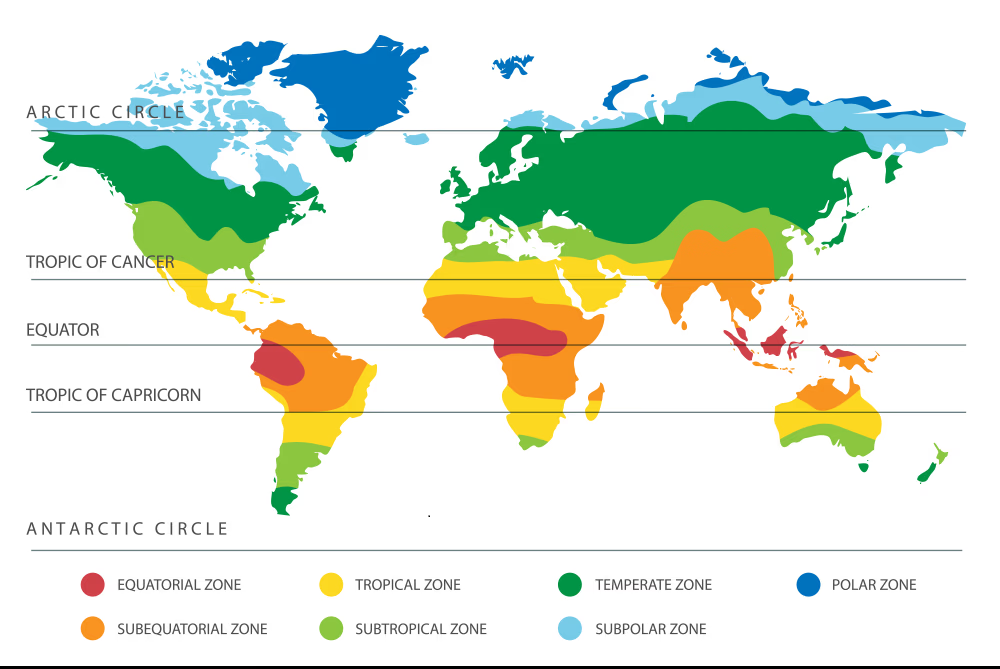-
Q. Climate and vegetation are interdependent. Analyze how different climatic regions of the world influence their natural vegetation patterns with examples from major climatic zones. (250 words)
03 Feb, 2025 GS Paper 1 GeographyApproach
- Introduce the answer by briefing the interlinkage between climate and vegetation
- Give Influence of Climate on Natural Vegetation Across Major Climatic Zones
- Highlight the Interdependence Between Climate and Vegetation
- Conclude by highlighting the factors causing disruption to this relationship.
Introduction
Climate plays a decisive role in determining the type, distribution, and characteristics of natural vegetation across the world.
- Temperature, precipitation, humidity, and seasonal variations influence the growth and survival of plant species, leading to distinct vegetation patterns in different climatic zones.
- This interdependence shapes ecosystems, biodiversity, and even human livelihoods.
Body
Influence of Climate on Natural Vegetation Across Major Climatic Zones
- Tropical Climate and Vegetation
- Tropical Rainforests (Equatorial Climate)
- Climate: High temperatures (25–30°C) and abundant rainfall (above 2000 mm) throughout the year.
- Vegetation: Dense, evergreen forests with multi-layered canopies. Dominant species include mahogany, ebony, rubber, and rosewood.
- Example: Amazon Rainforest (South America), Congo Basin (Africa).
- Tropical Grasslands (Savanna Climate)
- Climate: Warm temperatures with distinct wet and dry seasons; moderate rainfall.
- Vegetation: Tall grasses like elephant grass, scattered trees like baobab and acacia.
- Example: African Savanna (Serengeti) and Brazilian Campos.
- Tropical Rainforests (Equatorial Climate)
- Dry Climate and Vegetation
- Deserts (Arid Climate)
- Climate: High temperatures, low precipitation, and extreme diurnal temperature variation.
- Vegetation: Sparse vegetation with drought-resistant plants like cacti, acacia, and date palms.
- Example: Sahara (Africa), Thar (India) and Atacama (South America).
- Steppe (Semi-Arid Climate)
- Climate: Low-to-moderate rainfall, cold winters, and warm summers.
- Vegetation: Short grasses such as feather grass and buffalo grass, with few trees.
- Example: Eurasian Steppes, North American Prairies, and Patagonian Steppe.
- Deserts (Arid Climate)
- Temperate Climate and Vegetation
- Temperate Deciduous Forests
- Climate: Moderate rainfall (750–1500 mm), distinct warm summers and cold winters.
- Vegetation: Broad-leaved deciduous trees such as oak, maple, beech, and birch.
- Example: Eastern USA, Western Europe, and East Asia (China, Japan).
- Temperate Grasslands
- Climate: Moderate rainfall, hot summers, and cold winters.
- Vegetation: Dominated by perennial grasses like wheatgrass and ryegrass, with very few trees.
- Example: Prairies (USA), Pampas (Argentina), Velds (South Africa), and Steppes (Eurasia).
- Temperate Deciduous Forests
- Cold Climate and Vegetation
- Taiga (Boreal Forests – Sub-Arctic Climate)
- Climate: Long, harsh winters and short, cool summers; moderate precipitation
- Vegetation: Coniferous forests with pine, spruce, fir, and larch.
- Example: Canada, Scandinavia, and Siberia.
- Tundra (Polar Climate)
- Climate: Extremely cold temperatures (below freezing for most of the year), low precipitation (less than 300 mm).
- Vegetation: Treeless landscape with mosses, lichens, and dwarf shrubs.
- Example: Greenland, Arctic Canada, and Northern Russia.
- Taiga (Boreal Forests – Sub-Arctic Climate)
- Mountain Climate and Vegetation (Alpine Regions)
- Climate: Varies with altitude; lower elevations have temperate conditions, while higher elevations resemble tundra climate.
- Vegetation:
- Lower slopes: Deciduous forests (oak, chestnut).
- Mid-altitude: Coniferous forests (pine, fir).
- Higher altitudes: Alpine meadows with short grasses and shrubs.
- Example: Himalayas, Rockies, Andes, Alps.
Interdependence Between Climate and Vegetation
- Temperature Control on Growth: Warmer regions have dense forests, while colder areas have sparse, hardy vegetation.
- Also, vegetation play a key role in climate moderation for example Amazon rainforest act as a carbon sink
- Precipitation and Plant Density: High rainfall leads to luxuriant forests, whereas arid regions have xerophytic vegetation.
- Seasonal Changes and Deciduous Nature: In temperate regions, trees shed leaves in winter to conserve water and survive frost.
- Altitude Effect: Vegetation changes with altitude in mountain regions, mimicking latitudinal climatic variations.
Conclusion
Different climatic zones give rise to distinct biomes, shaping biodiversity and influencing human activity. However, this delicate balance is increasingly threatened by climate change, deforestation, and human encroachment, leading to habitat loss and ecological imbalances. Going forward, sustainable land-use practices, afforestation, and climate-resilient conservation strategies are essential to preserve the natural harmony between climate and vegetation.
To get PDF version, Please click on "Print PDF" button.
Print PDF





